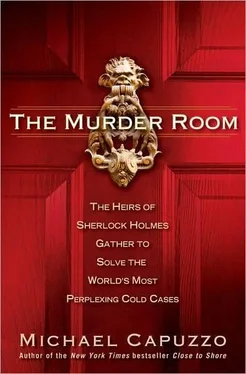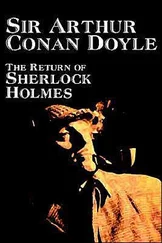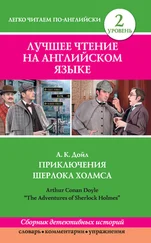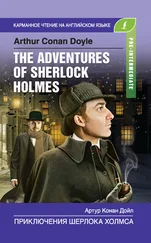The sculptor was feted with international publicity. The deputies marveled that Persico’s thin face, dyed dark hair, and mustache were the living image of the bust. “This case drove us crazy,” the top Brooklyn marshal, Michael Pizzi, told United Press International. “But the bust turned out to be accurate.” Said another marshal spokesman, “We hit pay dirt.”
PERSICO RAN OUT OF THYME, quipped the New York Daily News.
Bill Fleisher’s beard expanded around the oval of his mouth.
“Allie Boy Persico? I can tell you all about Allie Boy Persico!” Bender had been prohibited from discussing the case with his friend until it was wrapped up, but now, three weeks later, he was celebrating at his regular luncheon with Fleisher. Bender was in a jovial mood. Once again he’d predicted the unpredictable path of time across a killer’s face. The head he dubbed “Scarface” had been one of his most satisfying cases.
Fleisher wagged his big head. He felt that he and Bender were connected by whatever invisible strings the universe was pulling. “When I was with the FBI, I was assigned to the Colombo family squad in New York, and we were always chasing Allie Boy. We went to his farm in upstate New York and arrested him on an Alcohol, Tobacco, Firearms, and Explosives charge-he had an illegal rifle. It was early morning, and he smelled terrible. I don’t think he brushed his teeth. And he looked like he hadn’t slept. I interviewed him in the New York State Police barracks near his farm. He was a typical wiseguy of that era from Brooklyn, kind of gruff but charming. I can’t say he wasn’t a gentleman, except he’d kill you if you looked at him the wrong way.”
Bender laughed. The luncheon marked a major triumph of his new life in forensic art.
Fleisher raised an iced-tea toast. “I don’t know how you do it, Frank. You’re a major asset to law enforcement in this country. Allie Boy was a big fish. I remember he had a bad stomach. Lots of ulcers.”
“Allie Boy?” Bender leaned forward abruptly.
“Yeah.”
Bender’s mouth unhinged. His light hazel eyes got a shade lighter. He recalled one of the few things the marshals told him about Persico-the underboss had stomach problems. Allie Boy could eat only certain foods.
“My God, Penny Wright was on the money.”
Bender told Fleisher about the psychic whom Paul Schneider took him to and her prediction that the next fugitive the marshals caught after Vorhauer would have stomach troubles. Schneider had prayed it would be Nauss, whom he believed had stomach troubles from an old.22 wound in the gut.
“It’s Allie Boy,” Bender said with a far-off look, turning the words over like golden coins of prophecy. “Allie Boy Persico is the man with the bad stomach.”
Now they’d have to catch Nauss without unseen help.
CHAPTER 14. ON THE TRAIL OF THE WARLOCK
Before he escaped from prison in a pine armoire like Odysseus breaching the walls of Troy in a wooden horse, Robert Thomas Nauss had more in common with the monsters of antiquity than its heroes. He was a lean young man with a bearded face like a portrait of Jesus and soft brown eyes that blazed like a biker from hell. Men in Delaware County, Pennsylvania, quaked when Bobby Nauss strode into a bar with his Warlock gang members, bristling with black leather, chains, and threat. His soulless eyes were the last mortal sight of several pretty young women who vanished into the Tinicum marshes, police believed. Nauss was convicted of one murder and suspected of two others, in addition to his convictions for rape, robbery, and drug trafficking.
On the evening of December 11, 1971, the Warlock leader went on a date with his petite blond girlfriend, Elizabeth Landy, a twenty-one-year-old Philadelphia beauty queen. At the home of a fellow biker, they got into an argument and he tried to choke her, but Elizabeth hid in a locked bathroom. Later they made up and went to bed-where he bludgeoned her to death with a baseball bat. He strung her corpse up in a garage to show off to his biker buddies, and boasted, “She won’t bother me anymore.” Nauss cut off her hands and feet and covered her with lime to hasten decomposition and buried her in a shallow grave near the New Jersey Pine Barrens. Nauss was the first man in Pennsylvania history convicted of first-degree murder without a body. Landy has never been found. Nauss, too, had disappeared since his escape from Graterford with Vorhauer three years before.
Bender stood back and looked at his bust of Nauss, or what he thought time and trouble had done to Nauss’s boyish face. It was less than a month after Vorhauer’s arrest, and the U.S. Marshals were waiting for Bender’s age-progression bust to jump-start another investigation, to reveal their quarry. Equally important, his wife, Jan, was expecting him to perform a second miracle to keep alive his string of big federal cases and its promise of bigger money. He had almost nothing to go on, less even than he had known about Vorhauer. At least there had been recent sightings of Vorhauer in the Philadelphia area, raw material for his sketches. There had been no sightings or leads in the Nauss case. The last photographs of Nauss were nearly a decade old, his 1977 intake pictures from the prison. In those photos Nauss was five foot nine, a lean, muscular, 190 pounds, bearded. His powerful arms were tattooed with a blue parrot, a skull and dagger, a swastika, and the legend “Born to Lose.”
Bender studied the prison photograph of the menacing biker, then looked back at the bust. The bust depicted a conservative, thirty-five-year-old man in a button-down shirt collar. The new Nauss was clean-shaven, with short, neat, dark hair trimmed over the ears. The killer resembled a young Clark Kent. No matter how hard he tried to depict the biker as a burly thug in middle age, his fingers sculpted an all-American suburban family man.
Bender nervously ran his teeth over his lower lip. His muse was directing him; the harmony in nature and proportion that just felt right when he achieved it. But he could hear the marshals guffawing once more.
The mob hit man was a blond, and now the killer biker was Mr. Main Street, clean-cut Rotarian, straight as a banker’s son-in-law?
He saw their faces twisted with skepticism. Where we gonna arrest him, at the chamber of commerce breakfast? The country club?
Bender’s gut told him he was right once again. As a rule, he didn’t doubt himself any more than the moon questioned its pale light or the river its banks. He was the natural. He was the artist who saw dead people. Still, he possessed the humility of a perfectionist, the pride of a craftsman. He liked to check and recheck his assumptions. He was always eager to learn more.
After ten in the morning, he left the clean-cut killer’s head and walked back to his living area to clean up and put on a fresh shirt. He’d been up half the night, stripped to the waist like a rough tattooed John the Baptist with his hands on the head of a sadistic killer, mixing water and clay in a purification rite for a murdered girl. He needed some air. The city was filled with beautiful women and opportunity, he thought.
He combed his thinning blond hair in the mirror by the Fertility Godhead he had sculpted. Before noon, he threw on his coat and walked out into a bright fall morning, trailing his compact shadow along the broken sidewalk.
Eighteen blocks later, he went through a wide door into a great Egyptian-style lobby with sand-colored columns on all four sides supporting a balcony, and a chandelier that had dazzled presidents since Calvin Coolidge. The old Benjamin Franklin Hotel, affectionately dubbed “The Ben,” as it stooped over the years like a favorite tattered old uncle, had been the scene of a few crimes since 1925. But it had never seen anything like the hundreds of private eyes, blood-spatter experts, medical examiners, and even a few hypnotists who crowded the hotel that morning. The prestigious American Academy of Forensic Sciences convention was in town.
Читать дальше












